The SuperCam Remote Sensing Instrument Suite for the Mars 2020 Rover: A Preview
Spectroscopy
The SuperCam remote sensing instrument suite under development for NASA’s Mars 2020 rover performs laser-induced breakdown spectroscopy (LIBS), remote Raman spectroscopy, visible and infrared (VISIR) reflectance spectroscopy, acoustic sensing, and high resolution color imaging. The instrument builds on the successful architecture of the ChemCam instrument which provides LIBS and panchromatic images on the Curiosity rover, adding the remote Raman spectroscopy by frequency doubling the laser and using a gated intensified detector to obtain Raman signals at distances to 12 m. To the visible reflectance spectroscopy used by ChemCam, an AOTF-based infrared spectrometer is added to cover the 1.3-2.6 µm range that contains important mineral signatures. A CMOS detector provides color (Bayer filter) images at a pixel resolution of 19 µrad and an optical resolution of 30 µrad. Sounds are recorded via a Knowles Electret microphone, which is the same one that was unsuccessfully attempted on two earlier missions. The acoustic signals of the LIBS plasmas will provide information on the hardness of the targets, while other sounds (wind, rover sounds) will also be recorded. The laser, telescope, IR spectrometer, and camera reside on the rover’s mast and are provided by CNES, while the LIBS, Raman, and VIS spectrometers and data processing unit are built by LANL and reside in the rover body. A calibration target assembly provided by U. Valladolid, Spain, resides on the back of the rover. The overall mass of the instrument suite is 10.7 kg.
The SuperCam remote sensing instrument suite under development for the National Aeronautics and Space Administration’s (NASA) Mars 2020 rover performs laser-induced breakdown spectroscopy (LIBS), remote Raman spectroscopy, visible and infrared (VISIR) reflectance spectroscopy, acoustic sensing, and high-resolution color imaging. The instrument builds on the successful architecture of the ChemCam instrument, which provides LIBS and panchromatic images on the Curiosity rover, adding remote Raman spectroscopy by frequency doubling the laser and using a gated intensified detector to obtain Raman signals at distances to 12 m. To the visible reflectance spectroscopy used by ChemCam, an acousto-optic tunable filter (AOTF)-based IR spectrometer is added to cover the 1.3–2.6 µm range that contains important mineral signatures. A complementary metal-oxide semiconductor (CMOS) detector provides color (Bayer filter) images at a pixel resolution of 19 µrad and an optical resolution of 30 µrad. Sounds are recorded via a Knowles Electret microphone, which is the same one that was included but not used on two earlier missions. The acoustic signals of the LIBS plasmas will provide information on the hardness of the targets, while other sounds (wind, rover sounds) will also be recorded. The laser, telescope, IR spectrometer, and camera reside on the rover’s mast and are provided by the Centre national d’etudes spatiales (CNES), while the LIBS, Raman, and VIS spectrometers and data processing unit are built by Los Alamos National Laboratory (LANL) and reside in the rover body. A calibration target assembly provided by the University of Valladolid, Spain, resides on the back of the rover. The overall mass of the instrument suite is 10.7 kg.
Over the past two decades the National Aeronautics and Space Administration (NASA) has sustained an evolving capability to explore the Red Planet (Mars). Starting from the small 11.5-kg Sojourner rover that landed in 1997, and continuing with the twin 175-kg Mars Exploration Rovers (MER) (1) the program reached a high point in 2012 with the landing of the 900-kg Curiosity rover (2). The next step in NASA’s “Journey to Mars” program is the deployment of a sample-collecting rover planned for launch in 2020. Currently known simply as the Mars 2020 rover, this vehicle will be nearly a twin of the Curiosity rover in size, but will support a new payload to complement its mission of caching samples for return by a future mission. This payload includes fine-scale mineralogy, organics, and chemistry instruments on the rover’s arm, a weather station, a stereo zoom imager, a ground-penetrating radar, and a device to generate oxygen as a technology demonstration in anticipation of astronauts and in situ rocket fuel production. The seventh instrument, SuperCam, is a highly evolved version of the successful remote-sensing composition instrument, ChemCam, on the Curiosity rover (3,4).
Although SuperCam resembles ChemCam in its basic architecture (Figure 1), a number of capabilities have been added, including remote Raman spectroscopy, infrared (IR) spectroscopy, color (versus ChemCam’s panchromatic) imaging, and acoustic sensing. These techniques respond to the Mars 2020 Science Definition Team Report (5), which encouraged co-bore-sighted measurements by multiple techniques, and required that mineralogical characterization be part of the rover’s remote-sensing capabilities.
Figure 1: Schematic diagram of the SuperCam instrument. The mast unit is aimed at the target by the rover. The body unit receives light from the telescope via a 6-m long optical fiber. Both units have their own electronics-support boxes (EBOX); the mast unit contains its optics within a single box (OBOX). The calibration targets are mounted on the back of the rover.
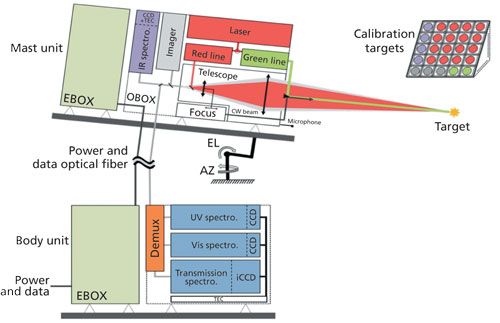
Capabilities and Techniques
Figure 2 shows representations of SuperCam’s spectral and imaging techniques. Laser-induced breakdown spectroscopy (LIBS) uses a focused, pulsed laser beam to interrogate rocks and soils remotely with >10 MW/mm2, producing brief, luminous plasmas (for example, see reference 6). The optical emission from these plasmas is recorded; the atomic emission lines are calibrated, providing quantitative elemental abundances for major, minor, and trace elements. ChemCam has returned ~400,000 spectra to date on >12,000 observation points along the rover’s traverse, documenting the elemental compositions comprehensively (7). The LIBS technique can be used for depth profiles below the surface of the rock or soil. An added benefit is that the plasma shock wave removes dust, providing a clear view of the target for the other techniques (8).
Figure 2: SuperCam’s four co-boresighted analytical techniques are accompanied by acoustic sensing. The LIBS UV-range spectrum shown in the upper right panel was taken by ChemCam, and represents about 20% of the overall spectral range (Table III). The coarse-grained igneous texture shown in the lower right panel is a ChemCam RMI image merged with color from Mastcam, simulating the SuperCam color RMI images. The remote Raman plot is courtesy of the University of Hawaii.
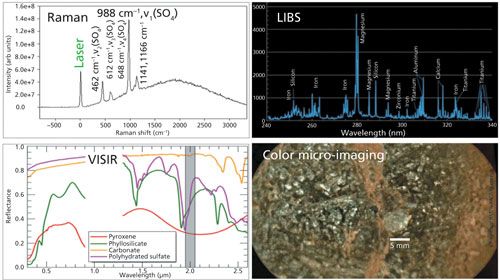
The two mineral techniques are Raman spectroscopy and visible and infrared (VISIR) passive reflectance spectroscopy. VISIR spectroscopy has been used extensively from orbit around Mars with the CRISM and OMEGA instruments on the Mars Reconnaissance Orbiter and the Mars Express spacecraft (9,10). ChemCam also provides visible-range passive spectroscopy (11). However, the IR spectral range is far more diagnostic, particularly because of IR adsorption bands of clay minerals, which are of the greatest interest in the quest to understand Mars’ past habitability. The gap in the VISIR plot in Figure 2 is necessary so the laser can be used for the other techniques, while the gray band indicates the region that is strongly absorbed by atmospheric CO2.
Raman spectroscopy is overdue on Mars, as a Raman instrument was de-scoped from the payload of the MER that landed in 2004 (12). Raman spectroscopy works by indestructively stimulating the surface with coherent light. A small fraction of the returned light is modulated by the molecular vibrational modes, and these are observed with a sensitive detector, yielding information about the mineral and molecular structure.
Although nearly all terrestrial applications of Raman spectroscopy are performed at close range using continuous-wave lasers, and two such instruments are now being built for Mars (18,19), SuperCam implements a remote-sensing version (for example, see references 13 and 14). Remote Raman spectroscopy is achieved by the use of a pulsed laser, telescope, and a time-gated intensified detector to effectively remove ambient light and amplify the weak Raman signal coming from some meters away. The time gating has the added advantage of avoiding interfering fluorescence from mineral sources. As organic matter is scarce on Mars, fluorescence interference from organics, which is prompt and cannot be easily removed by time gating, is expected to be minimal.
Context imaging of the spectral targets has proven to be highly important in the past, and so an imager is a necessity on the SuperCam. The Remote Micro-Imager (RMI), as it is called, has been upgraded from ChemCam’s panchromatic version (15) to Bayer-filter color using a complementary metal-oxide semiconductor (CMOS) detector.
Finally, acoustic sensing was just added in 2016 based on the recognition that the intensity of the sound from the LIBS plasma shock wave can provide details of the physical characteristics (such as hardness) of the target (for example, see reference 16). It will also contribute to basic atmospheric science, and will record the unique signature of many artificial sounds.
Table I gives a list of the key functional features and capabilities. The elemental composition can be determined to 10% accuracy and precision within 7 m of the rover. The twin mineral capabilities of VISIR and Raman spectroscopy provide detections at or below the 5–10% abundance range for major mineral groups in the distance range to 12 m, which is the expected limit of the Raman spectrometer. The VISIR, with only the sunlight for illumination, can operate much farther. As demonstrated by ChemCam, atmospheric characterization can also be done with the available spectrometers. The acoustic sensing of LIBS can be done to a distance of 4 m. The microphone will also be useful in listening to rover-generated sounds and studying microbursts of wind. The Mars atmosphere, with a pressure of only ~0.7 kPa, and consisting of mostly CO2, is expected to transmit sound only poorly (especially above 10 kHz) and slowly (240 m/s).
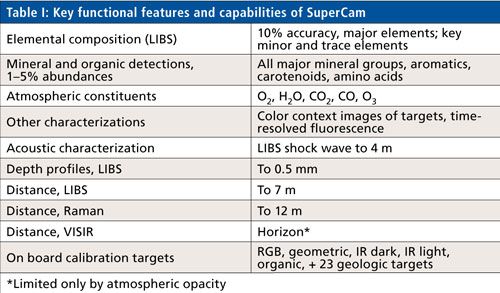
Instrument Architecture
Figure 1 provides a schematic diagram of the SuperCam instrument architecture, and Figure 3 shows isometric views of the major units. The instrument follows the overall design of ChemCam in that it is built in two major sections. The mast unit consists of the laser, telescope, RMI imager, IR spectrometer, and electronics for these functions. For the LIBS, Raman, and the visible portion of the VISIR spectroscopy, an optical fiber transmits the light from the telescope on the mast to a unit in the body of the rover, where spectrometers for these functions reside. This split design significantly reduces the amount of mass and volume that are needed on the rover’s mast. The respective mast and body units weigh 5.9 and 4.8 kg. A set of calibration targets is mounted on the back of the rover, including 23 geological targets representing major igneous mineral groups, carbonates, sulfates, and a number of whole-rock compositions, and five targets specifically for trace-element calibration. Color targets for the imager were added to these and IR targets were added for the VISIR observations.
Figure 3: Isometric models of the three parts of the SuperCam instrument.
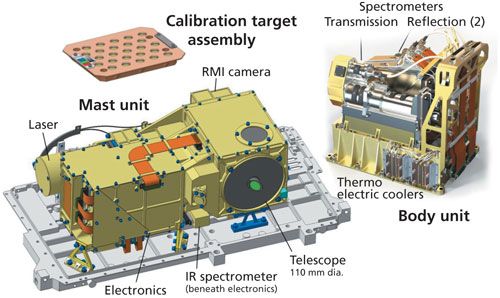
The separate units in Figure 1 also represent separate national contributions to the rover. The mast unit was contributed by and built in France, led by the Institut pour Recherche en Astrophysique et Planetologie (IRAP) in Toulouse, France, while the body unit was built by Los Alamos National Laboratory (LANL), where the instrument is being integrated. Jet Propulsion Laboratory, the developer and builder of the rover, provides the overall accommodation for the SuperCam instrument, including the optical and electrical cables. The calibration target is assembled and tested in Spain (the lead institution is the University of Valladolid), with contributions to the targets themselves from France, Denmark, Canada, and the United States.
The laser is integral to both the LIBS and Raman spectroscopic techniques. Its characteristics are given in Table II. Whereas ChemCam used an exotic Nd:KGW crystal (4), SuperCam returns to a more traditional Nd:YAG crystal that is thermally accommodated by being pumped by several diode bars that are optimized at three different temperatures. This provides an exceptional operating range of 40 °C. The LIBS technique uses the fundamental laser frequency, which is focused by the telescope to a tight spot on the target, providing the necessary high energy density to excite a plasma. For Raman spectroscopy the fundamental frequency is blocked; a frequency doubler is used to produce green light, the Raman bands of which can be detected by an intensified charge coupled device (CCD). This green beam enters a polarized prism that is part of a periscope that transfers the collimated beam around the telescope and aligns it on the target. The field of view of the focused telescope diverges slightly, matching the collimated 8-mm laser beam at 12 m. Beyond that the telescope field of view is under-filled by the laser-produced Raman footprint, and the signal decreases with distance. The energy of the laser beams can be reduced to limit saturation of the LIBS or Raman signals.
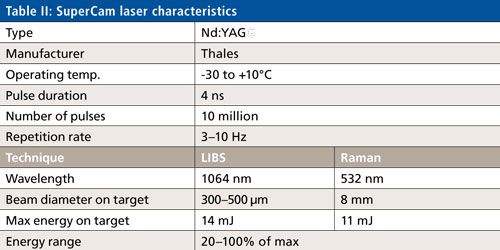
Table III lists some of the imaging and acoustic parameters. SuperCam achieves the same overall image resolution as ChemCam, but in color, by using a detector with four times the pixel density as ChemCam and employing a Bayer color filter. The microphone is the same model (Knowles Electret) as the ones that flew to Mars on the 1998 Mars Polar Lander (MPL) (17) and the 2007 Phoenix mission. However, neither mission had the fortune of recording sounds, as the MPL apparently crashed upon entry and the Phoenix microphone was never turned on for safety reasons. SuperCam thus expects to be the first scientific microphone to operate on the Red Planet. The Mars 2020 entry, descent, and landing (EDL) system also has cameras with microphones, but it is not known whether they will continue to operate once on the Martian surface. SuperCam’s microphone can record up to 3.5 min at a time, with its data packed in the same format as the RMI images. It can also record shorter durations, such as for individual LIBS plasmas.
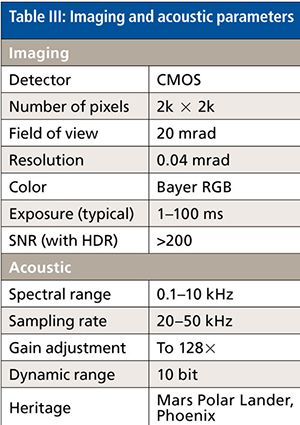
Several functions are handled by microprocessor in the mast unit (Figure 1), including focusing the telescope, determining the proper exposure for the RMI imager, and implementing a high-dynamic-range (HDR) imaging mode. All of these functions must be handled autonomously. To aid in focusing, a seed distance to the target within ±5% is provided by the rover’s stereo navigation cameras. The focus stage is scanned across positions corresponding to this distance range (4). Two independent algorithms can determine the focus. One uses a continuous-wave (CW) laser to illuminate the target; a photodiode at the back of the telescope records the intensity as the focus stage is scanned. A second method uses RMI images captured as the stage is scanned, and finds the maximum contrast between adjacent pixels in a small field of view at the center of the image. A separate RMI autoexposure algorithm sums pixel intensities from successive images with different exposure durations until the intensity is in the optimum range. The HDR mode significantly extends the dynamic range of the CMOS device, which has a lower natural range than traditional CCDs. The merging of several images at different exposure durations accomplishes this task.
Table IV describes the SuperCam spectrometers’ characteristics. The body unit contains the three spectrometers used for LIBS (Figure 3). Two of these handle the visible and violet portion of the VISIR spectra, while the IR portion is recorded in the mast. The weaker signals comprising the Raman spectra, produced over a period of ~4 ns by the pulsed laser beam, are recorded with a transmission spectrometer in the body unit. Ambient-light reduction is accomplished by use of a time-gated intensifier, which can record exposures down to 40 ns, orders of magnitude shorter than an ungated CCD. In addition to time-gating, the unit intensifies the signal by ~10,000, boosting the signal from only a few photons to levels that are well above the CCD noise level.
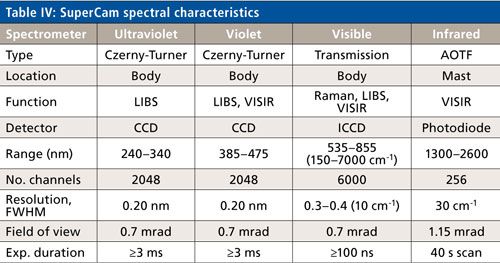
The ultraviolet (UV) and violet spectrometers are relatively simple crossed Czerny-Turner reflection spectrometers of ChemCam heritage (3). The transmission spectrometer is designed for higher photon efficiency required for Raman spectroscopy, which can be achieved with transmission gratings. This spectrometer uses several tricks to increase the product of the spectral range and pixel resolution. Light entering this spectrometer passes through a prism containing an internal dichroic mirror, splitting the light and projecting it onto two gratings. These gratings transmit the light to separated traces on the face of the intensifier. One of these two gratings is actually a compound grating. These twin gratings are mounted at slight angles from one another, once again projecting two traces that are separated on the intensifier face. The three resulting traces are intensified and focused onto the CCD, which reads each trace separately. The result is ~6000 channels (spectral traces do not go all the way to the edges, avoiding edge distortion) compared to the 2048 channels read by the other body-unit spectrometers.
Light in the IR band is transmitted to its spectrometer via a periscope in the mast unit (Figure 1). The light is passed through a crystal modulated by an acousto-optic tunable filter (AOTF). A radio-frequency transducer is attached to its side. For each frequency of the piezo a single wavelength is selected and scattered by ±4°. A beam block is positioned at 0° to reject the main beam. Two HgCdTe (MCT) photodiodes register the intensity. The wavelengths are scanned with a resolution of 30 cm-1 and a sampling frequency of half of that. The unit is designed to achieve a signal-to-noise ratio of at least 60.
The detectors of all four spectrometers are cooled. For the body unit spectrometers, the CCDs are cooled below 0 °C by thermoelectric coolers (Figure 3). These coolers are necessary because the rover body is generally maintained in the range of 5–35 °C by a fluid cooling loop from the radiothermal isotope generator that provides electrical power to the rover. The mast unit is only heated electrically to maintain a temperature >-40 °C. In this environment, the IR spectrometer is already relatively cold, which is necessary to minimize noise in the IR range. The photodiodes are further cooled by small thermoelectric coolers to ensure that they operate between -100 °C and -50 °C at any time of the day.
The fields of view of each spectral technique are illustrated in Figure 4. The target is Stephen, observed by ChemCam on Curiosity. The dust removal distance from several rasters is highlighted by the yellow circle. Several LIBS pits are highlighted with arrows. Representative footprints are also shown for Raman and IR observations. The VIS portion of VISIR has the same footprint as the Raman. Figure 4 and Table IV show that the IR spectrometer observes a larger footprint than the other spectrometers, which gives it increased signal levels at all times of the day. As mentioned above, the effective Raman footprint is governed by the spectrometer field of view to a distance of 12 m, and by the collimated 8-mm diameter laser footprint beyond that. The LIBS analytical footprint is smaller than the spectrometer fields of view and is specified by the tightly-focused laser footprint, expected to be 300–500 µm, with the larger diameter corresponding to the 7-m maximum LIBS distance (4).
Figure 4: Observational footprints of the different spectral techniques, shown on a target at a distance of 2.5 m from the instrument. At longer distances the LIBS footprint remains nearly the same size while the other footprints increase with distance as indicated in Table IV. The yellow circle shows the extent of dust removal. The yellow arrows point to LIBS pits; the Raman and IR footprints are shown in green and red. All spectral techniques are co-boresighted. Photo credit: NASA/JPL-Caltech/MSSS.

Status and Conclusions
As of early 2017 the SuperCam instrument has passed its critical design review. A high-fidelity engineering development unit is undergoing tests at Los Alamos to verify that requirements will be met. Parts are already being assembled for a qualification model, which will undergo full environmental tests including vibration, shock, and thermal performance. However, subsystems have already undergone many of these tests to provide greater confidence earlier in the program. In addition, some parts of the instrument have high heritage from the predecessor instrument. The flight model is scheduled to be integrated in 2018 and delivered to the rover later the same year. Launch of the Mars 2020 rover is scheduled for July of that year, with landing in February of 2021.
The SuperCam instrument is only possible because of the team’s previous experience with ChemCam. While the advantage of multiple co-boresighted techniques is very clear, the additional techniques will place a heavier burden on operations and data analysis. A relatively large international team is clearly a benefit in this regard. We are looking forward to the flood of data that SuperCam promises.
Acknowledgments
The SuperCam instrument is supported in the US by NASA’s Mars Exploration Program, in France by CNES, and in Spain by the regional government and private industry. In France, the hardware contribution to SuperCam is supported by the French space agency CNES, the Institut de recherche en astrophysique et planétologie (IRAP, Toulouse, France), the Laboratoire d’études spatiales et d’instrumentation en astrophysique (LESIA, Meudon, France), The Observatoire de Midi-Pyrénées (OMP, Toulouse, France), The Laboratoire d’astrophysique de Bordeaux (LAB, Bordeaux, France), The Laboratoire atmosphères, milieux, observations spatiales (LATMOS, Guyancourt, France), the Ecole Supérieure de l’Aéronautique et de l’Espace (ISAE-Supaero, Toulouse, France), and the Institut d’astrophysique spatiale (IAS, Orsay, France).
References
- S.W. Squyres et al., J. Geophys. Res. 108, 8062, doi:10.1029/2003JE002121 (2003).
- J.P. Grotzinger et al., Spa. Sci. Rev.170, 5–56, DOI 10.1007/s11214-012-9892-2 (2012).
- R.C. Wiens et al., Spa. Sci. Rev.170, 167–227, doi 10.1007/S11214-012-9902-4 (2012).
- S. Maurice et al., Spa. Sci. Rev.170, 95–166, DOI 10.1007/s11214-012-9912-2 (2012).
- J.F. Mustard et al., http://mepag.jpl.nasa.gov/reports/MEP/Mars_2020_SDT_Report_Final.pdf (2013).
- D.A. Cremers and L.J. Radziemski, Handbook of Laser-Induced Breakdown Spectroscopy (John Wiley and Sons, 2006), pp. 302.
- S. Maurice et al., J. Anal. At. Spectrom. DOI: 10.1039/c5ja00417a (2016).
- R.C. Wiens and S. Maurice, Elements11, 33–38 (2015).
- S. Murchie et al., J. Geophys. Res. 112, DOI:10.1029/2006JE002682 (2007).
- J.-P. Bibring et al., Science312, 400–404 (2006).
- J.R. Johnson et al., Icarus249, 74–92, DOI:10.1016/j.icarus.2014.02.028 (2014).
- A. Wang et al., “Concepts and Approaches for Mars Exploration,” proceedings The Lunar and Planetary Institute, Houston, Texas, 2000, pp. 304–305.
- R.C. Wiens et al., Spectrochim. Acta A61, 2324–2334 (2005).
- S.K. Sharma, Spectrochim. Acta A68, 1008–1022 (2007).
- S. Le Mouelic et al., Icarus249, 93–107, DOI:10.1016/j.icarus.2014.05.030 (2015).
- S. Palanco and J. Laserna, Appl. Optics42, 6078–6084 (2003).
- J.-P. Williams, J. Geophys. Res. 106, 5033–5041 (2001).
- F. Rull et al., Astrobiology in press (2017).
- L. Beegle et al., IEEE Aerospace Conference, March 2015, pp. 1–11, doi:10.1109/AERO.2015.7119105 (2015).
Roger C. Wiens is with Los Alamos National Laboratory in Los Alamos, New Mexico. Sylvestre Maurice is with the Institut de recherche en astrophysique et planétologie (IRAP) in Toulouse, France. Fernando Rull Perez is with the Centro de Astrobiologia, Unidad Associada CSIC-UVA, Cristalografia y Mineralogia Facultad de Ciencias in Spain. Direct correspondence: rwiens@lanl.gov

Laser Ablation Molecular Isotopic Spectrometry: A New Dimension of LIBS
July 5th 2012Part of a new podcast series presented in collaboration with the Federation of Analytical Chemistry and Spectroscopy Societies (FACSS), in connection with SciX 2012 — the Great Scientific Exchange, the North American conference (39th Annual) of FACSS.
Nanoparticle-Enhanced LIBS Mapping Uncovers Coffee-Ring Effect in Serum Analysis
February 27th 2025Researchers from the Harbin Institute of Technology and Harbin Medical University Cancer Hospital have demonstrated how optimizing silver nanoparticle concentrations can mitigate the coffee-ring effect in nanoparticle-enhanced laser-induced breakdown spectroscopy (NELIBS), improving the accuracy of elemental analysis in bioliquid samples.